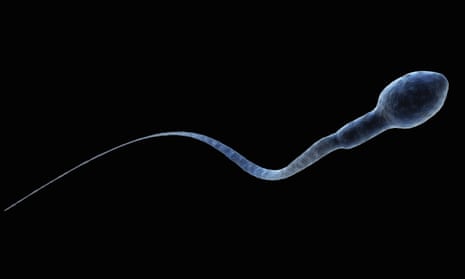Humans could face a reproductive crisis if action is not taken to tackle a drop in sperm count, researchers have warned after finding the rate of decline is accelerating.
A study published in the journal Human Reproduction Update, based on 153 estimates from men who were probably unaware of their fertility, suggests that the average sperm concentration fell from an estimated 101.2m per ml to 49.0m per ml between 1973 and 2018 – a drop of 51.6%. Total sperm counts fell by 62.3% during the same period.
Research by the same team, reported in 2017, found that sperm concentration had more than halved in the last 40 years. However, at the time a lack of data for other parts of the world meant the findings were focused on a region encompassing Europe, North America and Australia. The latest study includes more recent data from 53 countries.
Declines in sperm concentration were seen not only in the region previously studied, but in Central and South America, Africa and Asia.
Moreover, the rate of decline appears to be increasing: looking at data collected in all continents since 1972, the researchers found sperm concentrations declined by 1.16% per year. However, when they looked only at data collected since the year 2000, the decline was 2.64% per year.
“I think this is another signal that something is wrong with the globe and that we need to do something about it. So yes, I think it’s a crisis, that we [had] better tackle now, before it may reach a tipping point which may not be reversible,” said Prof Hagai Levine, first author of the research from the Hebrew University of Jerusalem.
Previous studies have suggested that fertility is compromised if sperm concentration falls below about 40m per ml. While the latest estimate is above this threshold, Levine noted that this is a mean figure, suggesting the percentage of men below this threshold will have increased.
“Such a decline clearly represents a decline in the capacity of the population to reproduce,” he said.
While the study accounted for factors including age and how long men had gone without ejaculation, and excluded men known to suffer from infertility, it has limitations, including that it did not look at other markers of sperm quality.
Allan Pacey, professor of andrology at the University of Sheffield, who was not involved in the work, praised the analysis, but said he remained on the fence over whether there is a decline.
“Counting sperm, even with the gold standard technique of [the laboratory process] haemocytometry, is really difficult,” he said. “I believe that over time we have simply got better at it because of the development of training and quality control programmes around the world. I still think this is much of what we are seeing in the data.”
However, Levine dismissed such concerns, adding that, in any case, the decline has been more pronounced in more recent years.
While it is unclear what might be behind the apparent trend, one hypothesis is that endocrine-disrupting chemicals or other environmental factors may play a role, acting on the foetus in the womb. Experts say factors such as smoking, drinking, obesity and poor diet might also play a role, and that a healthy lifestyle may help to boost sperm counts.
Tina Kold Jensen of the University of Southern Denmark said the new study recapitulated a concerning trend. “You keep on finding the same trend, no matter how many studies you include – that is a bit scary to me,” she said.
Prof Richard Sharpe, an expert in male reproductive health at the University of Edinburgh, said the new data showed that the trend appeared to be a worldwide phenomenon.
Sharpe said the decline could mean it takes longer for couples to conceive and, for many, time is not on their side as they are delaying trying to conceive until the woman is in her 30s or 40s, when her fertility is already reduced.
“The key point that needs to be made is that this is desperately bad news for couple fertility,” he said.
But, said Sharpe, “These issues are not just a problem for couples trying to have kids. They are also a huge problem for society in the next 50-odd years as less and less young people will be around to work and support the increasing bulge of elderly folk.”










